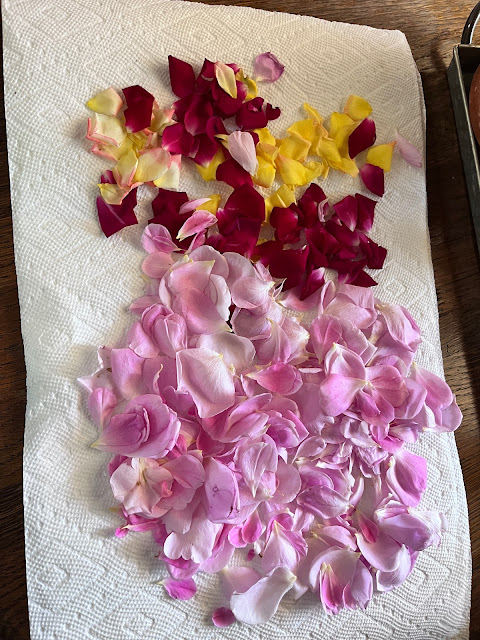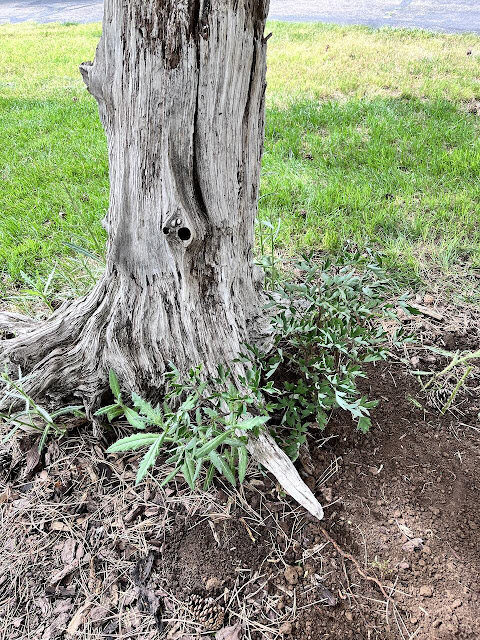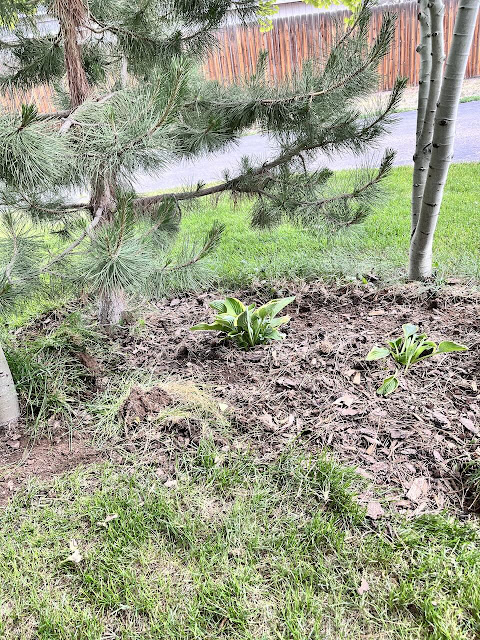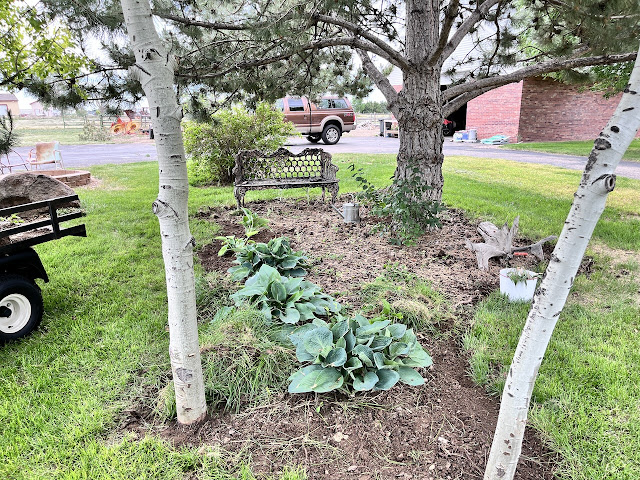I have to admit that when it comes to roses, I am bit of a rose snob because I only purchase registered roses, particularly Weeks roses. I consider them an investment in the perennial garden that will bloom all summer long, grow with few demands or complaints, and last for years. I've had some real rosy fiascos, too. Most memorable, expensive, and disappointing were the David Austins that just didn't thrive in our harsh winter climate; not so much because of the cold; rather, because I would guess, the dry winters. Or maybe they didn't like the dry summer heat. Who knows?
I have one of those lovely roses left, the climber Gertrude Jekyll, certainly a favorite.
On one our early visits to the local garden center, roses were not our shopping list; tomatoes and peppers were the mission, but a stroll through the rose collection did me in. I came home with two lovely Weeks hybird tea roses.
Painted Porcelain Legends
Gertrude, known for her fragrance is planted in our front entry courtyard. Her sweet perfume scents the walkway. I love her pink layered petals as they gradually swirl open. I don't often cut the roses because I just enjoy seeing them out my kitchen window, but I cut a few the other day to dry the petals for Lucy to try in homemade soaps.
For best results and most fragrant, the roses should be picked when they first open, but I just couldn't do that, waiting instead until the blooms were waning. I picked on red rose, Veteran's Honor and some of the little miniature roses that I purchased years ago on the sale rack at the supermarket. I stripped the petals away and spread them on a thick layer of paper towels and just let them air dry. The kitchen did smell wonderful.
Look at that pink!
I had a really hard time deciding where to plant the new roses. I really wanted them in the courtyard with the other roses because they do so well there, but there isn't any room, so I opted for the eastern exposure at the back of the house. This bed is relatively new. Though it was original to the house, it had a small evergreen tree that wasn't doing well, so we had it removed, giving plenty of room for the two new roses.
Yesterday we planted the roses next to the butterfly bush--Buddleja-- along with the infant hydrangea that survived the winter and my hibiscus.
This morning the roses looked wonderful and didn't seem to go through any shock.
Earlier in the spring the granddaughters were helping with spring clean up. With the center circle in the front growing on a wild rampage of bindweed, Canada thistle, and tons of self-seeded giant alums, the time has come to clean up this bed and redesign it, but first we have to remove the good stuff. So I talked to the girls about helping move the hostas. Little 9 year old Lily asked after a hour's worth of debris removal when were we going to move the hostages.
We transplanted 3 that day, waiting for the others to make their way through the soil and over growth so that we find them to dig them out.
So today we took more hostages and relocated them in the newly redesigned barn circle. Come along to see the transformation.
I thought I had written about the transformation of this garden out by the barn, but I guess not. In 2019 we held the HG's 50th class reunion here and the next week had a wedding in our barn. This spaces was a mass of over grown pine tress and weeds. The HG pruned the pines tress--raised their skirts as the arborist calls it--dug out weeds then rototiled it and laid sod. Today it is a beautiful shade garden in progress. These are 3 hostas that we transplanted earlier. They are doing quite well.
The Head Gardener was able to dig two healthy hostas which sort of naturally divided when he lifted them out of the ground, giving us 5 new plants. We also dug up a bleeding heart that will transplanted to the new Barn Circle shade garden, too.
I have a lofty plan for this nightmare of garden space. It went crazy wild last year with a particularly wet spring. The bind weed and morning glory weed took over, along with vinca, columbines, and the alums, which are an onion and are a large bulb, and they self sew and come up just as aggressively as the weeds do.
The plan: transplant the good stuff--if we can find those plants. Some will have to go through their blooming cycle before we move them like red hot poker (knophia) and some mounding mallow. Once the bloom cycles end, the Head Gardener will go with the week-eater then the mower, then the rototiller, with the final step to lay sod. The project take all summer as the plants do their thing. I'm excited to have grass instead of weeds.
The EZ-Go suffered a fatal engine malfunction last year, so we finally took in to have it repaired and now it is back on the job. What life-saver it is
as as we haul our payload from one spot to the next, along with tools and mosquito repellant.
as as we haul our payload from one spot to the next, along with tools and mosquito repellant.
I planted the bleeding heart at the base of the old stump, thinking that its pink blooms will look pretty next to the old, gray wood.
Three of the green hostas joined the elders, sort of following the outline of the bed.
The two variegated ones were placed in the smaller bed beneath two aspen--that pine tree must be take out. It was a self started, so it's very crowded.
Heather grew this elephant ear from the the bulb last year and gave it to me this year. She starts the bulbs in the house after the first of the year to get the plant growing then the plants them outside, and in the fall brings the bulbs in and lets them rest for the winter
I FaceTimed her to make sure that this spot between the two variegated hostas was good and it was.
And I said: That pine tree has to go.
So it went.
As if all that wasn't enough, the neighbor cut the lay earlier in the week and today put it in windrows then baled it. Fastest hay cycle ever!
I took a moment to savor the fragrance of newly baled hay.
With Sundance gone and Pop not able to chew hay, all the hay goes for the granddaughters' horses, so it's family affair to load up the hay.
From roses to hostage transplanting, to hay we end with Frank the Hog.
Hogs really don't get much respect. Supposedly they are ranked higher on the intelligence chart than dogs. I'm not sure what made Elinore decide to take on a hog 4-H project, but this is Frank, the marshmallow loving pig. He's in training now for his big show debut. She uses a hog whip--don't really know what it is called--to herd him, rather than lead him. He's fairly cooperative, especially for marshmellow rewards.
So there you have it.
It's what happens at the Garden Spot.
I'll be linking with Angie at Letting go of the Bay Leaf for Mosaic Monday.
Join us there
And thanks so much for visiting.






.jpeg)
.jpeg)

























Painted Porcelain...what an apt name for that beautiful rose, which does look as though it is painted. I have had no joy with 'hostages' as the slugs eat them overnight!
ReplyDeleteHello Ann, how lovely to see your blog. I enjoyed reading about it all, can smell your gorgeous rose petals (I love to make rose jelly with the most fragrant ones) and I could certainly smell that wonderful hay you had made. That and the chickens and playing round with a marshmallow loving pig are the things I miss from former farmlife. But all at its time. Enjoy a wonderful summer, love from Wales.
ReplyDeleteThere's always a lot to take pics of out there! Your garden is lovely of course and you and have a green thumb...you both do! I love your roses. We planted knock out roses here because the do so well in the Florida heat and bloom all year round. But I miss the scent of the roses like yours!
ReplyDeleteYour new roses are beautiful! Roses are my favorite flower as I have a June birthday. I live in a valley in the foothills west of Denver and have lots of deer roaming all the time though our gardens so I have to wrap wire around my rose bushes so the deer don't eat them. They would also devour the hostas ( love your granddaughters name for them!!) We have a retaining wall that we have been working on for ten years to make it as full with perennials and shrubs as we possibly can and we are slowly getting there!
ReplyDelete